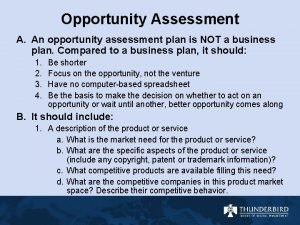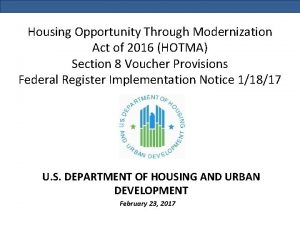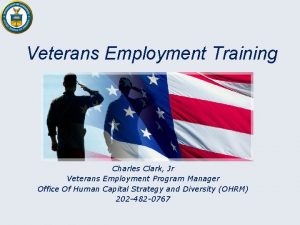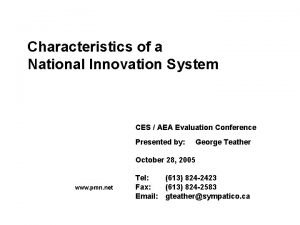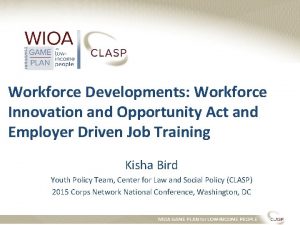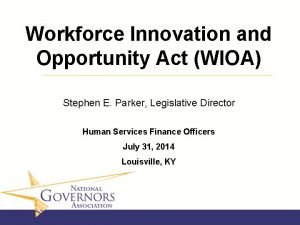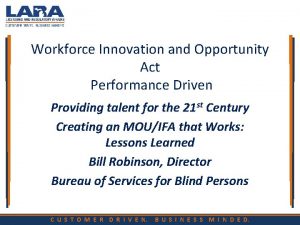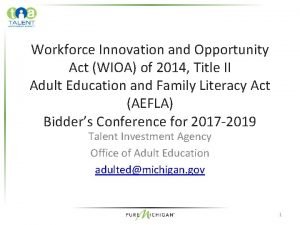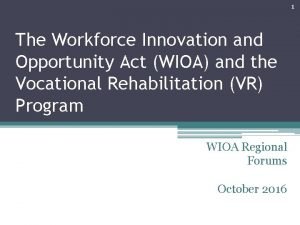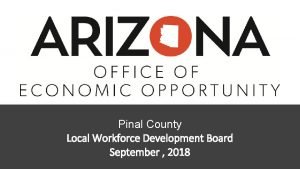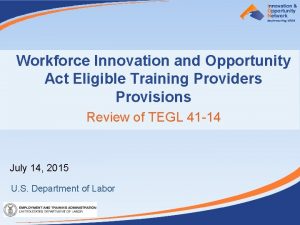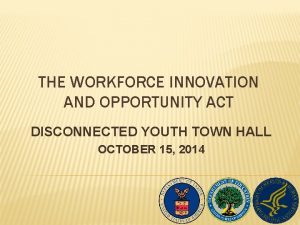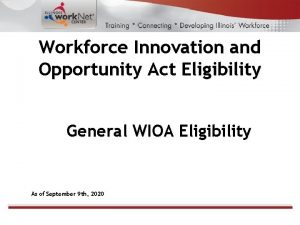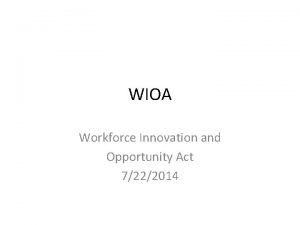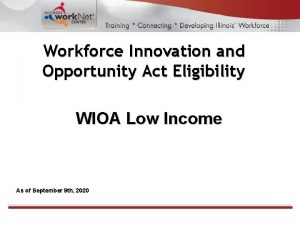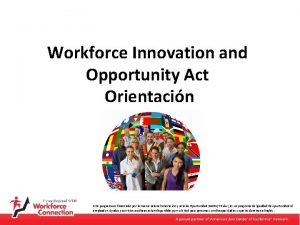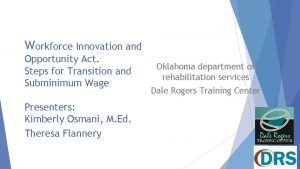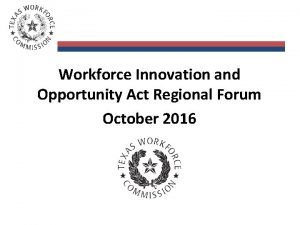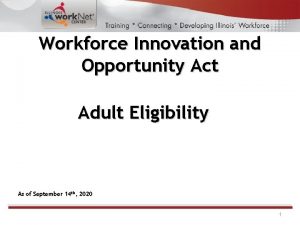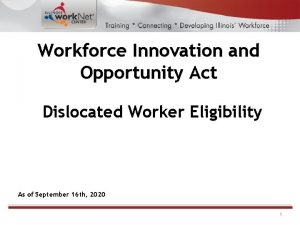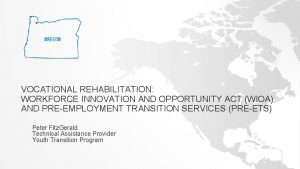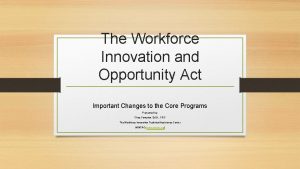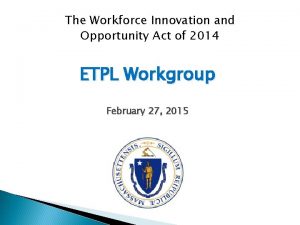WORKFORCE INNOVATION AND OPPORTUNITY ACT THE WORKFORCE SYSTEM





































- Slides: 37

WORKFORCE INNOVATION AND OPPORTUNITY ACT THE WORKFORCE SYSTEM Strengthening Partnerships Between Workforce Development and Adult Basic Education Association Julie Dincau Anne Kilzer Transitions Specialist Director MDE/Adult Basic Education Minnesota Workforce Council

WIOA PURPOSES “To increase, for individuals in the US, particularly those individuals with barriers to employment, access to and opportunities for the employment, education, training, and support services they need to succeed in the labor market… To support alignment of workforce investment, education, and economic development systems… To improve the quality and labor market relevance of workforce investment, education, and economic development systems… To increase the prosperity of workers and employers…” 2

WIOA SCOPE 6 Core Programs • Title I Adult, Dislocated Worker & Youth (DEED oversight, local implementation) • Title II Adult Education and Family Literacy (MDE oversight, local implementation) • Title III Employment Service (Wagner-Peyser) (DEED oversight and implementation) • Title IV Vocational Rehabilitation Services (DEED oversight and state/local implementation)

WIOA TARGETS FUNDS TO HELP THOSE WITH BARRIERS TO ECONOMIC SUCCESS Priority of Service strengthened – services targeted to public assistance recipients; individuals who are low-income and/or have barriers to employment Interim progress measure (“Measureable Skill Gains”) rewards programs helping hardestto-serve Disaggregated reporting by subpopulation Adult Education focused on learners with lowest skill levels 75% of Youth funds required to be spent on out-of-school youth New definitions (e. g. , individuals with barriers to employment, homeless individuals, basic skills deficient)

NEW OPPORTUNITIES FOR LOW-INCOME AND LOW-SKILLED ADULTS AND YOUTH Focus on low-income adults and youth Expands proven education & training Earn & learn Aligns planning and accountability

WIOA EXPANDS EDUCATION AND TRAINING OPTIONS Faster access to training when appropriate through the elimination of “sequence of services” and new “career services” & “training services” definitions Public reporting on training Encourages implementation of career pathways Contract training for cohorts and industry sector partnerships, including career pathways

WIOA ALIGNS PLANNING AND ACCOUNTABILITY POLICIES Required: unified planning (4 -year unified state plan for all 6 core programs) Optional combined plan (e. g. , CTE, TANF, SNAP E&T) Common measures across multiple programs (with variation for the Title I youth program) Better coordination of services to low-income individuals through shared accountability State/local plans must include youth and adults with barriers in their analysis, needs, vision, and goals Local Plans must describe how access to services will be expanded and how the local board will facilitate co-enrollment

WIOA ALIGNS PLANNING AND ACCOUNTABILITY POLICIES (CONT’D) Credential and skill gains measures allow more intensive training Credential attainment measure that includes recognized postsecondary credentials and secondary school diplomas or their recognized equivalent. New interim progress measure that identifies individuals who are making measurable skill gains while in an education and training program Performance expectations adjusted for economic and demographic factors Requires state and local performance expectations and levels to be adjusted based on economic conditions and participant characteristics

Shared Measurement Systems Developing a shared measurement system is essential to collective impact. COLLECTIVE IMPACT GUIDING PRINCIPLES

COLLECTIVE IMPACT GUIDING PRINCIPLES Collective Impact Process Mutually Reinforcing Activities | A diverse group of stakeholders working together by encouraging each participant to undertake the specific set of activities at which it excels.

WIOA IMPLEMENTATION: WHAT HAS BEEN DONE SO FAR? • Designation of Sixteen Workforce Development Areas • Creation of Six Workforce Development Regions • State Plan • Regional/Local Plans

REQUIRED LEVELS OF PLANNING State Plan DEED, GWDB Required Federal Title State Level Administrators Regional Plan WDA 6 LOCAL AREA BOARDS & CLEOs Regional Stakeholder Groups and Providers Local Plan Local Area 18 LOCAL AREA BOARD & CLEO Local Stakeholder Groups and Providers

ELEMENTS TO THE PLANNING Common Elements to State, Regional and Local Planning PROCESS Strategic Analysis – Looks at the state of the economy, the workforce and the workforce development system. Sets goals, vision and strategy. State Plan Operational Planning– Looks at the role of the State and Local Boards, strategy implementation, operating systems and policies and program activities. STRATEGIC ANALYSIS OPERATIONAL PLANNING Local Plan PROVIDER PARTICIPATION Regional Plan Provider Participation– Looks at the role of providers - as required by federal and state law, the MOUs and continuity of services among providers.

COLLECTIVE IMPACT THINKING AT ALL LEVELS OF PLANNING Shared Measurement Systems Common Agenda Mutually Reinforcing Activities MDE Leadership Continuous Communication Backbone Support Organizations Set by the Local Boards in the Regional Plan, Aligned with Governor’s Vision Review and Seek Alignment of Federal Reporting and Shared Data System Review and Seek Alignment of Required Activities ABE Consortia Leaders Establish State Level Communication Effort Regional Level Share and Align Performance Standards Local Boards Assess and Align Regional Resources ABE Directors Local Boards Establish Regional Communication Effort Constant Communication Set by the Governor In the Unified Plan Constant Communication State Level Champion the Needs of the Regions at State and Federal Levels Local boards Champion and Support the Regional Efforts Among the Partners Local Level Set by the Local Boards in the Local Plan, Aligned with Regional Plan Efforts are spoken of in terms of how they contributed to Shared Measures Ensure Continuity of Service Delivery Establish Local Level Communication Effort Champion and Promote the Outcomes of Local area efforts

STRATEGY AREAS FOR THE STATE/REGIONAL What Should We Focus. PLANS On? • Industry led sector partnerships – with in-demand occupations and pathways to family sustaining wages. • Career Pathway Models - focused on the selected industry and occupations in demand. • Employment Equity – addressing populations not benefiting from the economic recovery. • Technology – program data integration and better access to services

The Local Workforce Development Structure

OVERVIEW Workforce Development System Role of Local Elected Officials Workforce Service Areas Role of Workforce Boards Work. Force Centers Services Role of the Workforce Development Area Director

WORKFORCE DEVELOPMENT SYSTEM Minnesota’s workforce development system is comprised of a large community of stakeholders, including economic development, education, service providers, community leaders and citizens. Each play a vital role in ensuring that employers of all sizes have access to a prepared workforce and that jobseekers have access to services and resources that will enable them to obtain and keep good jobs.

Minnesota’s Workforce Development System Partners Governor’s Workforce Development Council Local Workforce Development Boards Work. Force Center Program Providers Employment and Economic Development (DEED) Department of Education (MDE) Minnesota State Colleges and Universities (Mn. SCU) Department of Human Services Community Based Organizations

QUIZ TIME!!! QUIZ: How many Workforce Development Areas are there in Minnesota? a. 87 b. 6 c. 18 d. 16

QUIZ TIME!!! QUIZ: Rural Minnesota CEP is the largest Workforce Service Area in Minnesota. How many counties does Rural Minnesota CEP serve? a. 19 b. 12 c. 37 d. 5

Minnesota’s Workforce Development Areas

QUIZ TIME!!! QUIZ: The sixteen delivery areas are organized under WIOA into six regions. Each region is comprised of two service areas except? a. Northwest b. Northeast c. Central MN d. Metro Area e. Southeast f. Southwest

WIOA WORKFORCE DEVELOPMENT REGIONS

Role of Local Elected Officials • Establish Service Area/Joint Powers Agreement • Act as Fiscal Agent • Appoint members of the Workforce Development Board

QUIZ TIME!!! QUIZ: There are two Workforce Delivery Areas that are Cities, rather than Counties or a Consortium of Counties. In that case, who would the Chief Local Elected Official be?

QUIZ TIME!!! QUIZ: WIOA states that a majority of each Workforce Development Board must be made up of people representing: a. Local Elected Officials b. Labor Unions c. Workforce Center Staff d. the Private Sector

WHAT IS WORKFORCE DEVELOPMENT BOARD? Governance Strategic Planning Service Delivery/Site Selection Oversight and Monitoring Local Convening Regional Planning/Coordinate Service Delivery with Other WDAs

ROLE OF THE DIRECTOR Staff Workforce Development Boards to ensure that services are: employer led. demand driven. meeting performance measures. Work with Local Elected Officials to: ensure program and fiscal integrity.

ROLE OF THE DIRECTOR Guide Work. Force Center staff efforts to: connect jobseekers to services and employers to jobseekers. prepare workers with skills in targeted key industries essential for economic competitiveness. provide responsive and relevant skills assessment and training in key industry sectors and clusters. Provide leadership by: Connecting with local workforce system colleagues. Convening sector strategy/career pathway discussions and initiatives. Learning about promising practices and opportunities for innovation. Acting as a resource for state and federal policy makers.

QUIZ TIME!!! How many Work. Force Centers are there in Minnesota? a. b. c. d. 32 49 16 87

WORKFORCE CENTERS (ONE-STOPS)

WORKFORCE CENTER PARTNERS Must: have one comprehensive one-stop center that provides access to physical services of the core programs and other required partners. Must: provide access to other programs specifically outlined in WIOA. May have: additional affiliate one-stop centers with any subset of partners, or specialized centers. May have: other public partners, local employers, community-based, faithbased, and/or non-profit organizations, as well as employment, education, and training programs provided by public libraries or in the private sector.

RESOURCE GUIDE Look through the resource guide. To which programs could you envision referring ABE Students?

ABE PROVIDER ON LOCAL WORKFORCE BOARD WIOA requires the state workforce board include “lead State officials with primary responsibility for the core programs” [101(b)(1)(C)(IV)(iii)(I)(aa)] and local workforce boards to “include a representative of eligible providers administering adult education and literacy activities under title II” [107(b)(2)(C)(i)]. Be ready to advocate for low-skilled adults. 35

PLANNING WITH YOUR WIOA TITLE I PARTNER Local Workforce Development Board – promote workplace learning for low-skill adults through WIOA incumbent worker provision… COORDINATION WITH EDUCATION PROVIDERS. — (A) IN GENERAL. —The local board shall coordinate activities with education and training providers in the local area, including providers of workforce investment activities, providers of adult education and literacy activities under title II, providers of career and technical education and agencies providing rehabilitation services. (I) reviewing the applications to provide adult education and literacy activities under title II for the local area, submitted under such section to the eligible agency by eligible providers, to determine whether such applications are consistent with the local plan; and(II) making recommendations to the eligible agency to promote alignment with such plan; 36

DISCUSSION If you were an ABE representative on a Workforce Development Board, what are three things you would want everyone to know about Adult Basic Education? 37
 What is opportunity assessment plan
What is opportunity assessment plan Grant implementation plan
Grant implementation plan Workforce innovation fund
Workforce innovation fund Mysite socccd
Mysite socccd Radical vs disruptive innovation
Radical vs disruptive innovation Macbeth act 2 summary
Macbeth act 2 summary Housing opportunity through modernization act
Housing opportunity through modernization act Veoa vs vra
Veoa vs vra Innovation system
Innovation system Hát kết hợp bộ gõ cơ thể
Hát kết hợp bộ gõ cơ thể Slidetodoc
Slidetodoc Bổ thể
Bổ thể Tỉ lệ cơ thể trẻ em
Tỉ lệ cơ thể trẻ em Chó sói
Chó sói Chụp phim tư thế worms-breton
Chụp phim tư thế worms-breton Chúa yêu trần thế
Chúa yêu trần thế Môn thể thao bắt đầu bằng chữ f
Môn thể thao bắt đầu bằng chữ f Thế nào là hệ số cao nhất
Thế nào là hệ số cao nhất Các châu lục và đại dương trên thế giới
Các châu lục và đại dương trên thế giới Cong thức tính động năng
Cong thức tính động năng Trời xanh đây là của chúng ta thể thơ
Trời xanh đây là của chúng ta thể thơ Mật thư tọa độ 5x5
Mật thư tọa độ 5x5 101012 bằng
101012 bằng Phản ứng thế ankan
Phản ứng thế ankan Các châu lục và đại dương trên thế giới
Các châu lục và đại dương trên thế giới Thơ thất ngôn tứ tuyệt đường luật
Thơ thất ngôn tứ tuyệt đường luật Quá trình desamine hóa có thể tạo ra
Quá trình desamine hóa có thể tạo ra Một số thể thơ truyền thống
Một số thể thơ truyền thống Cái miệng nó xinh thế chỉ nói điều hay thôi
Cái miệng nó xinh thế chỉ nói điều hay thôi Vẽ hình chiếu vuông góc của vật thể sau
Vẽ hình chiếu vuông góc của vật thể sau Biện pháp chống mỏi cơ
Biện pháp chống mỏi cơ đặc điểm cơ thể của người tối cổ
đặc điểm cơ thể của người tối cổ V. c c
V. c c Vẽ hình chiếu đứng bằng cạnh của vật thể
Vẽ hình chiếu đứng bằng cạnh của vật thể Fecboak
Fecboak Thẻ vin
Thẻ vin đại từ thay thế
đại từ thay thế điện thế nghỉ
điện thế nghỉ
